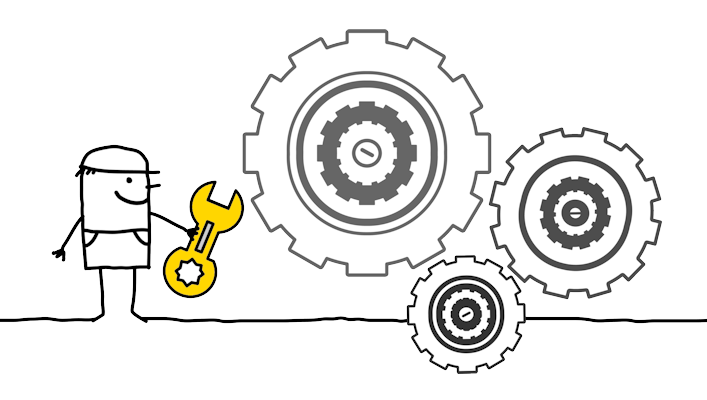Has your sales funnel run its course?
The traditional “sales funnel” concept explains how sales leads progress from mild interest to done deal. As the sales person works the pipeline, sales leads make their way toward the narrower end of the funnel. Modern CRMs, like Salesforce.com, act like a funnel. They allow sales people to manage cold leads and convert them into customers.
The problem with funnels is that they are passive. They fail to reflect the dynamic, integrated nature of brand-driven selling. People buy brands, not products. In most businesses, brand strategy lives on the marketing side of the fence, while the funnel lives on the sales side. This fundamental schism cripples the potential of brand-driven selling.
A SALES ENGINE doesn’t capture leads like a butterfly net; it generates them: 1) Position the Brand, 2) Engage the Customer, 3) Pitch the Customer, and 4) Close the Deal.
 It adds up to the acronym: PEP-C.
It adds up to the acronym: PEP-C.
1) POSITION:
A consistent brand experience
The goal of the Sales Engine is to leverage a consistent brand experience from the initial customer touchpoint to the final sale. A customer-focused brand position powers the Sales Engine and keeps the customer engaged throughout the Sales Engine process.
 Develop the Brand Message
Develop the Brand Message
A messaging platform distills the sales message into 5-7 key points. At the simplest level, the points guide the sales team like an elevator speech (shown below). The full messaging platform (or messaging architecture) fleshes out all the features and benefits to ensure consistent messaging across all sales pieces.
Use SEO-Focused Content
Search engines force web writers to align their content with the brand position. This is because Web searches are driven by keywords and meta-descriptions. By aligning the sales content with your brand position, your site becomes better optimized to deliver leads from Google.
2) Engage
Engage customers at every touchpoint
Consider every place your customers encounter your brand: answering the phone, service calls, proposals, automated emails, etc.. Each of these encounters is a touchpoint. Taking stock of every touchpoint is the starting point for your engagement strategy. In a Sales Engine approach, every touchpoint must communicate the brand position.

Engage Prospects with a Sales-Focused Web Site
Does your Web site actually sell? A sales-focused Web site addresses customer needs. Sales-focused sites use call-to-action links, videos, smart forms, step-by-step sales narratives, self-schedulers and other devices to engage the customer into the Sales Engine.
You’ve got a story to tell, so tell it:
Demos and Explainer Videos make a product or service simple to understand, easy to use, and a no-brainer to buy. They also automate the selling in your engine. Explainer videos typically use simple graphics or animation to explain complicated concepts. It doesn’t cost extra to embed videos in your Web site, so use them.
 Capture Leads and Schedule Demos
Capture Leads and Schedule Demos
There are several ways to capture leads on the Web:
- White papers and gated content that require submission of contact information.
- Interactive quizzes that capture contact information.
- Newsletter sign-ups
The better way to capture leads is to ignore gimmicks and instead, deliver a compelling value proposition that solves a customer need.
If your product requires solution selling or one-on-one sales time, offer an immediate way to schedule a demo.
3) PITCH
Make Every Customer Contact Count
I’m amazed that sales people talk to prospects without recognizing that this conversation may be their one and only chance to sell this customer. Instead of shooting the breeze, introduce a visual component. “Hey, do you have access to the Web? Great, go to this URL.” The goal is to make it 100 percent effortless.
SlideShark lets you send prospects to a personal broadcasting page as described above. This way, the sales person can deliver a seller-controlled presentation in real-time without forcing the prospect to log in, download, or use special software like Webex or Go to Meeting.

Presenting a handful of targeted slides engages the prospect and enhances your sales pitch. A few tips:
- Ask questions that qualify customer needs in real-time (Question-Based Selling). Accelerate the selling process by addressing those needs early in the process.
- Create a library of ready-to-go slide modules that address specific customer requirements, highlight product lines, cite case studies etc. Use branching in the PPT structure to guide the prospect through a targeted presentation during the call.

- At all cost, avoid the “PowerPoint look” of header and bullets (despite it being in the clipart above). Work with a designer or PowerPoint guru to deliver a full-on brand experience.
4) CLOSE
The proposal or RFP can be the most crucial selling document in the Sales Engine process. Unfortunately, proposals are often several pages of boilerplate and numbers.
- Think of your proposals as selling documents — just like brochures. Stretch the design envelope for what’s normal for a proposal or RFP in your field.
- Apply solid layout and design to every proposal.
- Summarize the pitch, illustrate with brand-inspired graphics, and deliver the brand experience along with the costs.
 Sales Proposal Automation
Sales Proposal Automation
How do you know if your client opened your proposal? Online proposal generators offer instant notification when your client opens the proposal. More importantly, these tools streamline proposal development from a library of ready-designed brand-driven modules.
Online proposals fit seamlessly into the Sales Engine approach. They also connect with CRMs like SalesForce. With your brand platform and messaging architecture in place, your proposal template can be designed as a branded selling experience.
Proposal generators maintain a consistent brand experience, accelerate the proposal writing process, and connect to many CRMs. These include Quote Roller, BidSketch, Qvidian, TinderBox and countless others.
The Bottom Line
The Sales Engine approach leverages your brand position, automates selling, and eliminates gaps in the sales process. Best of all, the Sales Engine approach converts prospects into customers without relying on that tired old funnel.

